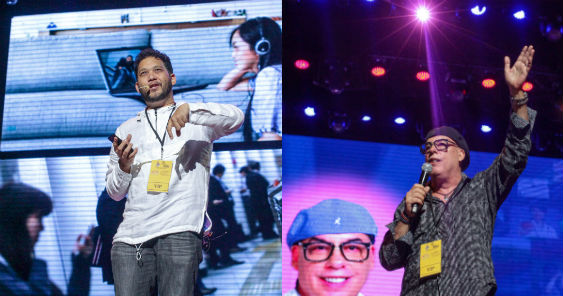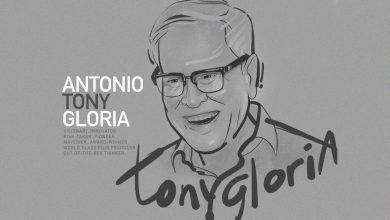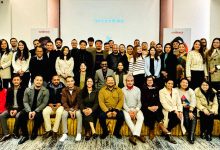Disrupt or be disrupted
By Nicai de Guzman
“The entertainment industry is ripe for disruption and anyone can play in that space.”
This is what Joe Caliro, Senior Advisor for Creative Marketing, Globe Telecom, said during the 4th adobo Festival of Ideas: “Creativity at the Heart of Digital: Data, Tech, and AI.”
Caliro and his colleague, Quark Henares, Director of Globe Studios, talked about how to elevate and innovate the content and entertainment space, or as they liked to call it, “How to stir sh*t up.”
“When someone is disrupting, innovation is at its highest opportunity. You don’t have to be the one that disrupts, you just have to know it’s happening and go for the ride. Create something a little different,” Caliro urged the room full of creatives.
Caliro said that the biggest disruption didn’t come from the first innovator. Sometimes it’s the second, third, fourth, or even fifth person who followed in the footsteps of the first and just did things better.
“This is key because the window closes fast and you need to fail fast, learn fast,” he said.
Content platforms evolution
Caliro said that one of the most obvious examples of how disruption manifest are platforms. The entertainment industry became witness to how people changed their behavior in consuming content throughout the decades. In music, people started with the radio, then they moved on to clubs during the disco era, then finally, to MTV. Now, we have music streaming.
“Do you know what’s Spotify has done? Spotify has killed the video star,” Caliro said.
In the film industry, people used to watch in big theaters. Then movie goers moved on to tapes and rentals, DVDs, pay per view, then to television. Now, people are consuming films online. From movies that span for hours, people have proven that they are also open to short videos that can last for just a minute long. One of his examples was Nas Daily that now has 1 billion views for its 1 minute videos.
“The windows are also being disrupted. Normally film to DVD is 60 days, for TV, three months,” he said, pointing out the fact that the window for a film to be shown in another platform is getting shorter.
In the theater scene, most theater production companies do a regional show and if they’re lucky, you go to Broadway or West End and you take it on a tour, according to Caliro.
“Content platforms? No such thing in the theater space,” he said.
This is why Globe is also co-producing with 9 Works Theatrical to produce local, Broadway-quality shows.
“The government does not fund the arts in the Philippines. Companies are funding the arts in the Philippines,” Caliro pointed out.
“In August we’re about to do something no one has done. Put local theater in a content platform,” Caliro said.
What they have noticed is that most shows are staged in Manila but what if you’re from the provinces? You have to fly in and that would be too costly. This is why Globe is preparing for a change in this industry and maybe even livestream and put these shows in a content platform.
“This is the new world. Everyone of these brands have the same problem. They need localized content. Netflix launched western content. Where’s the local content? It’s not there. Whether it’s four minutes or four hours,” he said.
“The key to these platforms is they need local content. And here’s the secret – in the media space in the telco space, content is king. Data is queen. The holy grail is knowing who’s consuming it,” Caliro added.
Content vs. Entertainment
Working in the telco industry that has information on people’s behavior on how they consume content, one of the things Henares has noticed is that the ways of watching has changed. One of the things he mentioned is the lean back vs. lean forward experience.
“Lean forward means you’re more engaged and you’re doing so many things at the same time. You share and discuss right away and there’s more competition for your attention,” he said.
Lean back is more passive but you usually have a second screen so you’re also working on your phone or laptop, he added.
“Is there a difference between content and entertainment? Content is something you put in a container and so as a person who wants to entertain or touch lives, you don’t want to be called content,” he pointed out.
In Globe, Henares said that they aim to entertain and not just put out content to sell their products. They don’t want to be “super obvious” in selling Globe’s data plans or phones. One of the ways they’re doing this is by thinking like their customers. By doing a lot of research with what’s important to their customers, they created not just content but aimed to entertain them with the videos they’ve produced.
An example is their video series Scenezoned with Solenn Heussaff. It shows Solenn traveling all around the country but its aim is actually to sell their Samsung phones.
“It’s a telco company saying it’s not a telco company anymore. We’re a media company,” Henares said of their approach.
Another way of achieving this is by following the Hero-Hub-Help framework, according to Henares.
“Hero is the thing you spend money on, your big ad,” he said, adding that the Hero content defines the look of the campaign or the rest of the content.
For their Rush Within campaign, Henares showed a video that explained their concept of being inspired by content and entertainment to create your own.
This was followed by their Hub content or regularly scheduled push content designed for your prospect. For this, they have created a series of profiles on interesting creators, while maintaining the visual look for each video.
Finally, they have followed up with Help content which explained ways of joining the creative industry such as how to get into filmmaking.
Globe has forayed well into the waters of the entertainment space, co-producing the sequel to On The Job and even Lav Diaz’s critically acclaimed musical, Ang Panahon ng Halimaw. And all of these is aimed at the ultimate goal of shaking things up with how brands create content and entertainment and how they consume them, Henares said.
“Imagine all the different ways of watching,” he said.
Watch the full session here:









